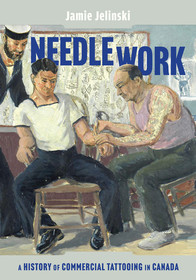
Needle Work
A History of Commercial Tattooing in Canada
Series: McGill-Queen's/Beaverbrook Canadian Foundation Studies in Art History 44; 44;
- Publisher's listprice GBP 42.00
-
20 065 Ft (19 110 Ft + 5% VAT)
The price is estimated because at the time of ordering we do not know what conversion rates will apply to HUF / product currency when the book arrives. In case HUF is weaker, the price increases slightly, in case HUF is stronger, the price goes lower slightly.
- Discount 10% (cc. 2 007 Ft off)
- Discounted price 18 059 Ft (17 199 Ft + 5% VAT)
Subcribe now and take benefit of a favourable price.
Subscribe
20 065 Ft

Availability
Not yet published.
Why don't you give exact delivery time?
Delivery time is estimated on our previous experiences. We give estimations only, because we order from outside Hungary, and the delivery time mainly depends on how quickly the publisher supplies the book. Faster or slower deliveries both happen, but we do our best to supply as quickly as possible.
Product details:
- Publisher McGill-Queen's University Press
- Date of Publication 30 October 2025
- ISBN 9780228025078
- Binding Paperback
- No. of pages424 pages
- Size 254x178 mm
- Weight 666 g
- Language English
- Illustrations 153 photos, colour throughout 700
Categories
Short description:
Complemented by over 150 rarely seen illustrations, Needle Work moves from coast to coast and across more than one hundred years to provide a key chapter in the history of the international emergence and development of commercial tattooing.
MoreLong description:
In 1891 J. Murakami travelled from Japan, via San Francisco, to Vancouver Island and began working in and around Victoria. His occupation: creating permanent images on the skin of paying clients.
From this early example of tattooing as work, Jamie Jelinski takes us from coast to coast with detours to the United States, England, and Japan as he traces the evolution of commercial tattooing in Canada over more than one hundred years. Needle Work offers insight into how tattoo artists navigated regulation, the types of spaces they worked in, and the dynamic relationship between the images they tattooed on customers and other forms of visual culture and artistic enterprise. Merging biographical narratives with an examination of tattooing's place within wider society, Jelinski reveals how these commercial image makers bridged conventional gaps between cultural production and practical, for-profit work, thereby establishing tattooing as a legitimate career.
Richly illustrated and drawing on archives, print media, and objects held in institutions and private collections across Canada and beyond, Needle Work provides a timely understanding of a vocation that is now familiar but whose intricate history has rarely been considered.
More



